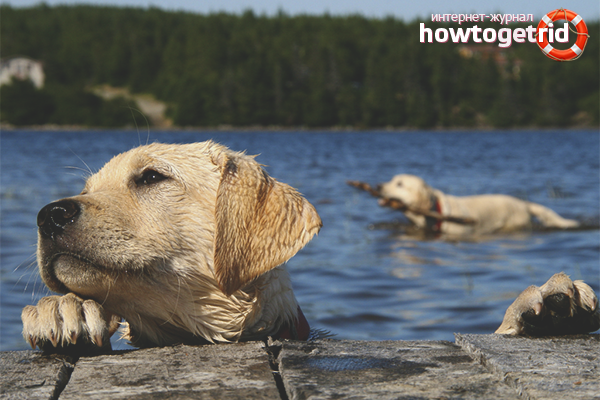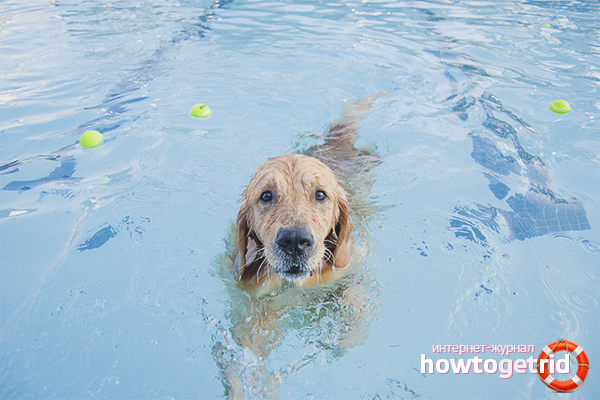The content of the article
Not all dogs love water. For this reason, many owners are faced with a problem, resting near a reservoir with their four-legged friend. To relieve the animal of stress, it is necessary to gradually instill in him a desire to swim.
Training a dog for water procedures
Before accustoming the dog to water, you should learn some simple commands that will help the pet cope with fear.
Method number 1. For company
- Teaching a pet teams that will help him love the water requires some effort.
- The main role in this aspect is played by the fact that the dog is attached to the owner and constantly wants to be near him. Introduce the pet to the water at a shallow depth.
- Come into the lake and joyfully call the dog behind you. Thus, without fear of depth, a four-legged friend will splash with you in the water.
Method number 2. Team Aport!
- Some dogs swim well, but for some reason they dislike water. If your pet belongs to this type of animal, use a little trick.
- Throw a stick into the water, give the order "Aport!". The “Next!” Command works in a similar way. Go swimming with your favorite pet. It is important to consider that four-legged friends swim faster than humans.
- Perhaps it’s easier for a dog to wind circles around you than to swim at the same speed. Regardless of the team, monitor the health of the pet. His breathing should be even and his eyes calm.
Method number 3. Swimming vest
- When swimming, dogs at the instinct level are rowed with their paws as they would walk on the ground. Based on this aspect, many owners believe that their pets are simply obliged to be able to swim.
- Unfortunately, the situation is different. There are breeds of dogs that swim poorly or even drown. These include animals with a large body and small paws.
- This does not mean that they do not want to frolic in shallow water. It is not at all necessary to drag a pet to a depth where he will be completely uncomfortable.
- In case the owner intends to send the pet away from the coast, a swimming vest for dogs was created specifically for this.
- Having chosen the appropriate size, the four-legged one will not feel discomfort and fear of depth.
Gradual Dog Training
- Give up the obsession to throw the dog deep and expect it to float. Perhaps the pet will do so, but the stress he receives will be stored in his memory for life.
- In the future, the dog will begin to panic fear of water, even when you want to bathe it in the bathroom. Acquired emotional trauma will forever change the animal’s mental background.
- Accustom your pet to water gradually, starting with shallow water. It is desirable that the place was not crowded, quiet, calm. Take a walk along the shore to get your pet comfortable.
- Enter the water ankle-deeply, in a gentle voice, call your pet along. If this method is ineffective, use your favorite toy or dog treat.
- If a four-legged friend does not want to immediately go into the water, break the training into several days. First, teach your dog to shallow water, give her the opportunity to get used to this depth.
- Try to play with your pet. Be patient, the pet should get used to the water itself without experiencing negative emotions. In the end, you get a confident pet that accompanies you during the swims.
Upright swimming
- A similar style of swimming dogs in common people called the "candle." There are frequent cases when the animal is not at all afraid of water, but also cannot swim.
- At a depth, the pet is able to reach the bottom with its hind legs, and with its front legs, it forms a lot of splashes around itself. Without touching the bottom, the dog continues to swim in an upright position, like a candle.
- In this case, the pet may lose orientation and panic. First, calm the dog in the water. Enter the lake with it to a sufficient depth, slightly hold the animal in the abdomen.
- Let your pet "cut" circles around you, sometimes letting go of your hand. Soon, the pet will get used to it and will be able to scurry back and forth near you. Swimming is a useful activity for both the owner and the dog.
- Making swims, the muscles develop without harm to the joints. Strengthens the immune system, ligaments, heart. When playing in water, do not throw the toy for the dog too far so that you can save the animal if it flounders and panics.
Dog First Aid
- If a dog has a disaster and has been under water for some time, do not panic. Lay the pet so that the croup is raised and the chest is on the ground. In this position, all the fluid will come out of the lungs.
- Remove foreign objects from the mouth. If the dog does not breathe, start artificial respiration. To begin with, put the pet on its side so that the body is slightly higher than the head.
- With sharp, gentle movements, press on the animal’s chest with two palms folded crosswise (as is the first aid to a person). Spend 6-7 repetitions, then squeeze the jaws of the animal tightly, blow air through the nostrils several times.
- Repeat the exercises in turn (pressing — blowing) until the pet shows signs of life. As soon as the dog wakes up, immediately send it to the veterinary clinic.
Practical tips
- Do not try to throw the puppy into the water. Otherwise, you will get a dog that will always be afraid of water. Accustom your pet to swimming gradually. Play in shallow water, walk along the shore.
- In the summer, allow yourself a prank to run with a dog in the rain. In no case do not scold the pet if he flops into a puddle. Raise a pet as a small child. It is these positive emotions that should be deposited in the dog’s memory.
- When the pet learns to swim, do not leave it unattended, constantly look after the dog and do not lose sight of it. Swimming has a good effect on physical fitness, but also exhausts greatly. Make sure that the pet can return back after the swim and does not get too cold.
- Let the dog rest and recover. Pay special attention to puppies, older individuals, and breeds with a disproportionate body.
- Avoid swimming in the midst of heat. Make sure that swimming takes place before meals. Do not also let the dog into the water after an intense run, it can get sick.
- If you are in a hot time on a pond, make sure that the pet is in the shade. Do not try to throw a stick with the “aport!” Team into the river over. The dog will not cope with the flow, which will lead to serious consequences.
Follow simple guidelines on how to teach your dog to swim, and the result will not keep you waiting. Teach your pet to water correctly, preferably from puppyhood. Do not listen to people who say that the dog is already swimming. Follow the step by step instructions. Do not exhaust the animal to exhaustion.
Video: how to train a dog for water procedures












Submit